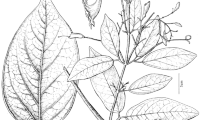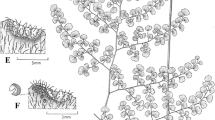Abstract
The genus Piper is well known for their medicinal and economic potentials and is distributed in tropical and subtropical regions of the world. Majority of the taxa under the genus Piper are morphologically confusing because of the wide range of variations within the vegetative characters. A total of 22 morphological characters, including both vegetative and reproductive characters were studied at a mature stage in 35 accessions of Piper taxa collected from North East India representing 12 species. The morphometric variables were analyzed using variance and Principal Component Analysis. It was carried out to identify the useful characters that can contribute to distinguish various species. The Unweighted Pair Group Method and Arithmetic Average clustering method for the vegetative traits and reproductive traits show two principal clusters. The present study revealed the importance of the morphological characters in delimitation of taxonomic grouping of the confusing species.


Similar content being viewed by others
References
Anonymous (2009) Wealth of India. Raw materials, vol 8. Council of Scientific Institute and Research, New Delhi
Bhutani KK (2008) Herbal Wealth of North East India: database and appraisal. National Institute of Pharmaceutical Science and Research, Punjab
Borstein JA (1989) Taxonomic studies of the Piperaceae. Journal of the Arnold Arboretum 70:1–55
Burger WC (1972) The evolutionary trends in the Central American species of Piper. Brittonia 24:356–362
Candolle CD (1912a) Piperaceae Meedoldinae Herbarii Vratislaviensis I. Feddes Repert 10:518–521
Candolle CD (1912b) Piperaceae novae Peninsula Malayana. Record of the Botanical Survey of India, Calcutta, vol 6, pp 1–27
Candolle CD (1914) Piperaceae Meeboldianeae Herbarii Vratislaviensis II. Feddes Repert 10:297–300
Candolle CD (1923) Piperacearum clavis analytica. Candollea 1:66–415
Das AK, Tag H (2006) Ethnomedicinal studies of the Khamti tribe of Arunachal Pradesh. Indian J Tradit Knowl 5(3):317–322
Dyer LA, Palmer ADN (2004) Piper: a model for studies of phytochemistry, ecology, and evolution. Kluwer, Boston
Gajurel PR, Rethy P, Kumar Y, Singh B (2008) Piper species (Piperaceae) of North East India (Arunachal Pradesh). Bishen Singh Mahendra Pal Singh, Dehra Dun, India
Gilbert MG, Xia NH (1999) Notes on the Piperaceae of China. Novon 9(2):190–198
Hoogendijk M, Williams DE (2001) Characterizing the genetic diversity of home garden crops: some examples from the Americas. In: Watson JW, Eyzaguirre PB (eds) Home gardens and in situ conservation of plant genetic resources in farming systems. IPGRI: Proceedings of the second international home gardens workshop, Witzenhausen, Germany, pp 34–40
Hooker JD (1886) The flora of British India, vol 5, pp 78–96. Reeve and Co., London
IPGRI (1995) Descriptors for black pepper (Piper nigrum L.). International Plant Genetic Resources Institute, Rome, Italy
Jamir NS, Rao RS (1990) Fifty new or interesting medicinal plants used by the Zealangs of Nagaland, India. Ethnobotany 2:11–18
Jaramillo MA, Manos PS (2001) Phylogeny and patterns of floral diversity in the genus Piper (Piperaceae). Am J Bot 88(4):706–716
Kanjilal UN, Kanjilal PC, Dey RN, Das A (1940) Flora of Assam, vol 4. Omsons Publications, Delhi
Long DG (1984) Piperaceae. In: Grierson AJS, Long DG (eds) Flora of Bhutan, vol 1, no 2. Royal Botanic Garden, Edinburgh
Martinez-Calvo J, Gisbert AD, Alamar MC, Hernandorena R, Romero C, Llacer G, Badenes ML (2008) Study of a germplasm collection of loquat (Eriobotrya japonica Lindl.) by multivariate analysis. Genet Resour Crop Evol 55(5):695–703
Morris K, Richard H, Roger SH (1969) Tumor inhibitors XLV crotepoxide, a novel cyclohexane diepoxide tumor inhibitor from Croton macrostachys. J Org Chem 34:3898–3902
Myers N, Mittermeier RA, Mittermeier CG, da Fonseca GAB, Kent J (2000) Biodiversity hotspots for conservation priorities. Nature 403:853–858
Ohlyan R, Kandale A, Deora GS, Rathore V, Chahal J (2012) In vitro screening of dry fruit extracts of Piper attenuatum for antioxidant and anticancer activity. Med Chem Res. doi:10.1007/s00044-012-0122-y
Pandey A, Tomer AK, Bhandari DC, Pareek SK (2008) Towards collection of wild relatives of crop plants in India. Gent Resour Crop Evol 55(2):187–202
Peeters JP, Martineelli JA (1989) Hierarchical cluster analysis as a tool to manage variation in germplasm collection. Theor Appl Genet 78:42–48
Podgornik M, Vuk I, Vrhovnik I, Mavsar DB (2010) A survey and morphological evaluation of fig (Ficus carica L.) genetic resources from Slovenia. Scientia Horticulturae 125:380–389
Rahiman BA (1987) Geographical distribution of the genus Piper in India. Curr Sci 56(13):666–668
Rahiman BA, Nair MK (1987) The genus Piper L. in Karnataka, India. J Bombay Nat Hist Soc 84:66–83
Ravindran PN, Nirmal Babu K (1996) Numerical taxonomy of South Indian Piper L. II. Principal component analysis of the major taxa. Rheedea 6:75–86
Ravindran PN, Balakrishnan R, Nirmal Babu K (1992) Numerical taxonomy of South Indian Piper L. (Piperaceae) 1, Cluster analysis. Rheedea 2:55–61
Singh B, Singha BK, Phukan SJ, Borthakur SK, Singh VN (2012) Wild edible plants used by the Garo tribes of Nokrek biosphere reserve in Meghalaya, India. Indian J Tradit Knowl 11(1):166–171
Smith JF, Stevens AC, Tepe EJ, Davidson C (2008) Placing the origin of two species—rich genera in the late cretaceous with later species divergence in the tertiary: a phylogenetic biogeographic and molecular dating analysis of Piper and Peperomia (Piperaceae). Plant Syst Evol 275:9–30
Srivastava S, Gupta MM, Prajapati V, Tripathi AK, Kumar S (2011) Sesamin a potent antifeedant principle from Piper mullesua. Phytother Res 15:70–72
StatSoft Inc (2010) STATISTICA (data analysis software system), version 10. www.statsoft.com
Tamuly C, Dutta PP, Bordoloi M, Bora J (2013) Antifungal and antioxidant pyrrole derivative from Piper pedicellatum. Nat Prod Commun 8(10):1451–1454
Tebbs MC (1989) Revision of the Piper in the New World 1. Revision of characters and taxonomy of Piper section Macrostachys. Bull Nat Hist Mus Lond 20 (2):117–158
Tebbs MC (1990) Revision of the Piper in the New World 2. Revision of Piper Section Churumayu. Bull Nat Hist Mus Lond 19:117–158
Tebbs MC (1993) Revision of the Piper in the New World 2. Revision of Piper Section Lepianthes and Radula. Bull Nat Hist Mus Lond 23(1):1–50
Acknowledgments
The work is funded by the Department of Biotechnology (DBT), Government of India. The authors are thankful to the Department of Forestry, NERIST, Itanagar, Arunachal Pradesh and Assam Agricultural University, Assam for supplying some working materials. Thanks are also due to Dr. D.K. Hore, Consultant, IBSD for his valuable suggestions and comments in preparing the manuscript.
Author information
Authors and Affiliations
Corresponding author
Rights and permissions
About this article
Cite this article
Chanchal, C., Thongam, B. & Handique, P.J. Morphological diversity and characterization of some of the wild Piper species of North East India. Genet Resour Crop Evol 62, 303–313 (2015). https://doi.org/10.1007/s10722-014-0172-8
Received:
Accepted:
Published:
Issue Date:
DOI: https://doi.org/10.1007/s10722-014-0172-8




